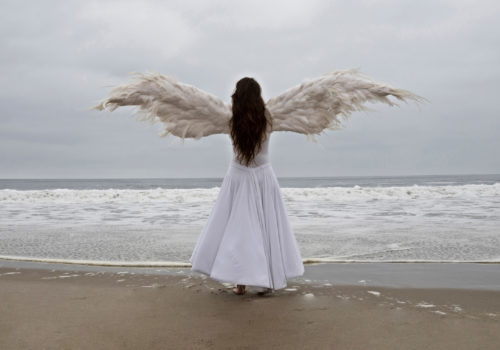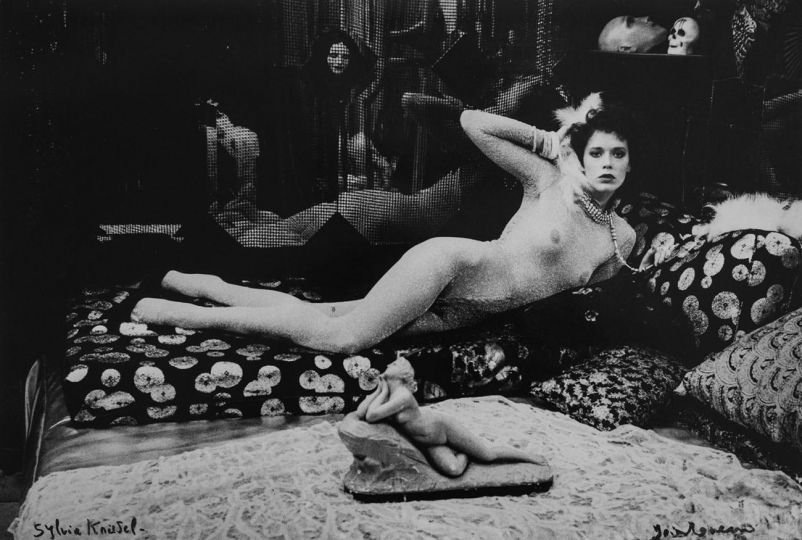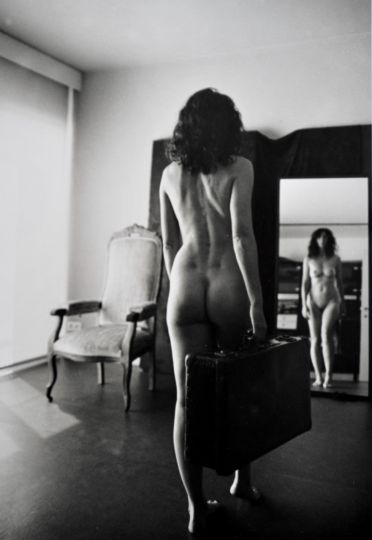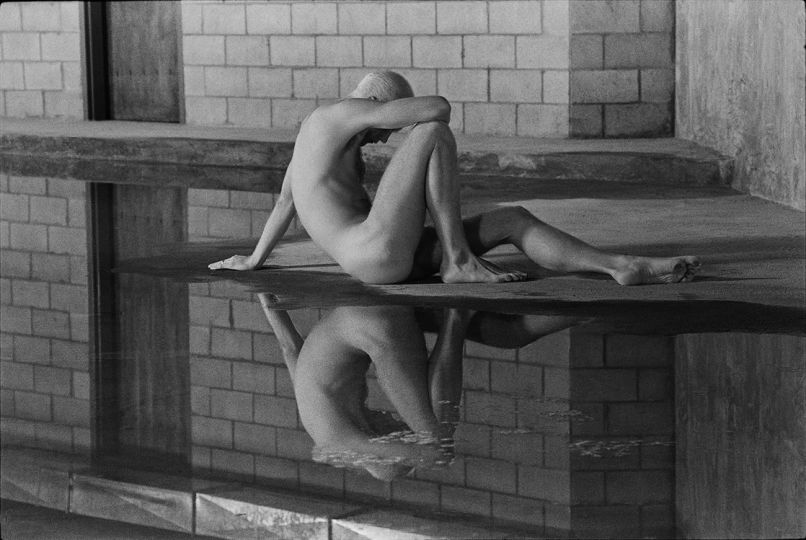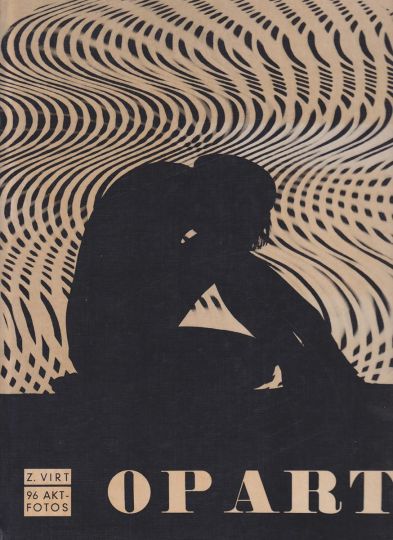Woman to Woman Regard de femmes
Woman to Woman is about a friendship between the photographer (Mattei) and her subject (Yochim). It is a collaboration between seer and seen, where the roles become a fluid exchange; documented with photographic images expressing change and growth and the passage of time.
Michele Mattei, born in Paris, currently lives in Los Angeles, has a long and distinguished career as a journalist, photojournalist, filmmaker, multi-media artist and fine art photographer. She opened the first Latin American Bureau of Gamma, the premiere French photo agency and traveled throughout the continent covering political stories and civil unrest as well as working in China and Africa.
Her work has been exhibited worldwide and her photographs are in the collections of the Smithsonian National Portrait Gallery, the National Museum of Women in the Arts (NMWA)in the archives of MoMA and in private collections.
She photographed and interviewed many illustrious artists and had a solo show for the 25th anniversary of the NMWA named “Fabulous!” about women who contributed significant changes in our world: Betty Friedan, Louise Bourgeois, Dolores Huerta, Betye Saar, Agnes Martin.
Her fine art photographic series inform her search for finding visual representations of our states of being. She works in the space where creativity, spirituality and technology seem to coalesce. “Emergence” is a journey to reveal the hidden and the invisible, the liminal state between being and not being.
“Quantum of Light” is inspired by Nikola Tesla’s research on energy.
“The Grids of Winter” is a visual reflection on our experiences of the past months and our intricate relationship with technology for connectivity to the world.
Documentary film productions include:
“The Longest Holiday” (New York Film Festival)
“Through This World But Once” about Ethiopian children (Toronto Film Festival); “Stories Of A Collection” on Wilhelmina Holladay, the founder NMWA.
Elizabeth Yochim is a dancer, street performer, teaching artist, filmmaker, and arts professional. She creates, directs, and produces performances and workshops internationally.
She combines her training in classical ballet, somatic exploration, eco-psychology and Italian Renaissance art history. She founded Participlay to offer her art + play design theory approach to museums and galleries to create the experience of art through non-verbal docent tours. She also presented a TEDx talk, The Power of Play, at the University of Southern California in Los Angeles.
Her performances explore themes of connection—to us, each other, and the environment through the body. They are designed to rekindle memories of how people gathered for centuries to share their lives through telling stories, singing songs, and dancing. The works are participatory and invite people to contribute their own gestures, stories, and memories; thereby blending the line between performer and audience.
Elizabeth began creating street performances in 2004, and in 2013 she mounted her signature project, Angelbird. Dressed as an all-white winged creature she has performed as Angelbird all over the world, across ten continents from the Royal Mile of the Edinburgh Festival Fringe to the edge of Rome’s Vatican City, and from Berlin and Paris to the red rock country of Southern Utah just to name a few. She has written, performed, and produced the art films Angelbird and Essence.
Drawn to creating new community rituals in and around the cycles of life, death and rebirth, Elizabeth recently received certification as a death midwife which involved training in sitting with the dying, and to guide and hold space for family members and friends to memorialize the dead in their own intimate and personal ways.
Since 2016 Elizabeth has performed, taught, and designed in-person and virtual experiences internationally with the Nomadic School of Wonder for individuals, creative agencies, and corporate companies such as Google.
Elizabeth was raised in Kalamazoo, Michigan and received her degree in art history from the University of Michigan. She studied arts abroad and speaks Italian fluently. With background as an art world professional and former gallery director, she founded Yochim Arts, a fine art appraisal and art advisory firm based in Los Angeles. She is currently working on publishing her first book, Woman to Woman, Regard de Femmes in collaboration with photographer Michele Mattei due out in 2022.
Michele Mattei
@michelematteiphoto
Elizabeth Yochim
IG @angelbirdflight
Anna Dusi
IG @speccioluce
Q: LANZA : Describe your collaboration and process on this decade long project?
MATTIE : Woman to Woman, Regard de Femmes is a photographic journey documenting the friendship between Elizabeth and myself.
I met Elizabeth at the Palm Springs Photo Festival years prior. She was the Director of Timothy Yarger Fine Art. She advocated for my work with the gallery and soon after, she began representing my work. In the following years our fondness for each other grew and we became friends.
We began taking photographs in 2009. Each photoshoot was its own time capsule. The photographs were not studied after each session. They were briefly reviewed and then archived. It was never meant to be a ten-year project.
When I first photographed her, she was in her mid-thirties. She was at a critical time in her life just having ended a significant relationship with her life partner. Her confidence seemed shattered, and she struggled to make herself whole again. I proposed to photograph her and give her a reflection of the wonderful being she was, a magical, beautiful soul, a vibrant bundle of energy.
There was no regularity in how we scheduled the photoshoots. They happened in response to an impulse to come together in the studio to explore how Elizabeth was changing and evolving and to capture a particular moment of transformation. The Angelbird saw one of its first representations in front of my camera.
In the Fall of 2020 upon viewing the most recent photoshoot, a story and visual narrative began to emerge. We agreed to write about our experience and have spent the past year reflecting on our journey: what it means to see and be seen and questioning the role of the female gaze.
YOCHIM : I met Michele through the gallery and really loved her work. I was impressed by her eye and how she was championing women through her photography. When she said that she wanted to do a photoshoot with me I experienced both excitement and trepidation. On the day of that first photoshoot I called her and said that I couldn’t come. I proceeded to give her a long list of excuses: I didn’t have the right clothes, the right dress, I wanted to lose weight, I didn’t get my hair cut. She wasn’t buying any of it. Finally, I confessed: “I didn’t get my eyebrows done.” Silence. Then she said, “Why don’t you grab a few dresses and just come over.”
What happened next changed my life. At the studio, without much preparation, in one of my most cherished Gunne Sax dress and no make-up, we began.
I love to jump, and we wanted to capture me airborne. I kept at it, which reminded me of ballet class, where I would repeat a movement again and again until it felt right. This was similar and therefore familiar, and I enjoyed the challenge. Timing the jump, the camera, the light, and the balance of reaching and relaxing made me feel satisfied down to the tip of my tailbone. My heart was on fire and I came alive. All of this was fun for me and an extension of our friendship: Michele and I are a match made in heaven. She is a task master, making me jump over and over on bare cement, and I am determined to not quit until we got the shot.
I availed myself to Michele and her lens. Nothing was off limits in her presence. It wasn’t a risk to stand before her naked, emotionally or physically. I felt comfortable. I felt safe. I came alive within her gaze. She was the perfect observer. The perfect photographer.
The day I sat beside Michele in her studio looking at the photographs from our first shoot, changed how I see myself. At first, it felt like I was looking at someone else. From this vantage point, the veil of criticism, expectation, discontent, and judgement was suspended. I saw something else, and I thought, “Who is this woman?” I fell in love with her beauty, her vulnerability, her heart, her body, her light and her shadow. I felt such tenderness toward her, such empathy.
Q: LANZA What is Angelbird how did this idea come about, what is the meaning and its history?
YOCHIM : The Angelbird was lived forward and understood in reverse. The idea came to me in a series of dreams. I felt that I was remembering a time in which I had wings and that I could fly. I was experiencing a personal crisis and overwhelming grief over my mother’s death. I was questioning my relationships, my career, who I was in the world and who I wanted to be. There were two kinds of dreams: dreams of tsunami’s as well as dreams of flight. I surrendered to them both and began to step away from the life I had created and unbeknownst to myself constructing a new life based on my dreams. I decided to become a street performer in Europe. I worked with an established Hollywood wing maker, with the pertinent name of Motherplucker, to design a custom-made pair of white wings, bought a one-way ticket to Berlin and took off.
That summer I started performing in Germany, Italy and Poland. I thought of myself as a bird, and my performances reflected the cycles of a bird’s life from nesting to flight. The response was extraordinary. I found that it touched something profound in everybody.
I knew from the beginning that whatever this was, this journey of remembering my wings, was not just about me, but about something much greater.
The audiences I encountered thought me as much an angel as they did a bird. After that summer I called myself Angelbird. Some say that the Angelbird is my alter ego. I say that it represents one of the truest parts of me.
MATTIE : I watched as Elizabeth developed the idea of Angelbird. I was bemused. How did she, my Midwestern, erudite, gallery director friend decided to don a pair of wings, and dance in the streets of Europe?
How did she summon the courage to get rid of all of her belongings and let go of what culture and society had designed in her name? How did she gather the strength to risk damaging her professional career? I was afraid for her.
Q: LANZA How did Angelbird evolve into Woman to Woman, Regard de Femmes. Describe its development in the context of the photographic series?
YOCHIM : This is what came to me as I was thinking about how to answer your question. What came first, the woman or the egg? Am I a bird? Am I an angel? Am I a woman?
Michele’s photographic practice and my creative pursuits combined alchemically to create the lives we have led over the past ten years. Because the Angelbird is an intimate part of who I am, it is therefore an intimate part of our collaboration.
Woman to Woman, Regard de Femmes, at its core, is the relationship between Michele and I, woman to woman; as captured in the studio over a ten-year period. It is a retrospective of transformation of mind, body and spirit.
We think we drive the creative process. I have learned that we create the conditions for the creative process to flourish and hopefully carry us beyond our “ideas” or expectations.
The energy and power behind the emergence of this winged creature was an all-encompassing, transcendent force. It was a primordial energy, and it came from what I like to call the fertile unknown, the mystery. Could it have summoned Michele and I to document the process? Possibly. I have thought, only looking at the process in reverse that performing on the streets as the Angelbird gave me an expanded relationship to my deceased mother. Surrendering to the emergence of this winged creature brought something entirely new to my life, which was the pervasive presence of her.
MATTIE : Woman to Woman, Regard de Femmes created the space for Angelbird to have a place to emerge and feel safe in the trust we established.
In one of our sessions, I was photographing Elizabeth as part of a series of work called Emerging Essence. It relates to the moment just before waking up when we are in the liminal space before integrating our body.
Elizabeth was living the metaphor: she was stepping out of her own skin, exploring the layers of her own self, transmuting into another incarnation. Each photograph symbolized her struggle to change and grow.
Elizabeth had to perform rhythmic movements an inordinate number of times: squat, stand, reach! Repeatedly, she was reenacting her struggle to stretch toward her future and stand for herself. We were completely focused. We could only hear the throbbing of the flashes and the 1, 2, 3 counts of the silent metronome of our mind.
Both of us knew that there was more in this session than the visible.
When she showed up at the studio with her first pair of wings, I was hopping between fear and anticipation. The wings were spectacular, immaculate, soft, vibrant. She slipped her arms in the feathered sleeves and started to dance. The feathers fluttered with the rhythm of her gestures.
The wings had become part of Elizabeth’s persona and body. They had merged with her spirit. When she moved her arms there was a sensation of tremulous excitement; when she flew through the air she disappeared into her wings. It was mesmerizing to witness.
Elizabeth had transformed herself into a mystical being. She had embodied the persona of an angel. A transmutation.
It was really quite magical. I relaxed my fears. I did not know where this experience would lead but I knew she was going to be OK.
Q : LANZA What have you both experienced from this and what were the challenges?
YOCHIM : When we sat down after the most recent photoshoot there was an awareness of discovery at the body of work that laid before us. It felt as if we were seeing something for the first time. There was a sense of joy and appreciation. Somehow we had captured something meaningful and beautiful. It was as if we stumbled upon a treasure that we had built together. There has been a codification of our friendship. As we wrote into the journey over the past year and talked about the process it has grown and deepened and we have become closer because of it.
We are opinionated women and like that about the other. We did have arguments and sometimes hurt each other’s feelings. But we didn’t sit on those feelings for long. My ongoing and concerted effort is to turn towards feelings no matter how scary they are. I have found that it’s the only way to re-establish connection, trust and safety. I think this was a new way for Michele. I think that I’m a rare person in her world to express oneself with such open communication. I have watched her over time become more expressive with me immediately after there is a miscommunication or misunderstanding. This has helped me to trust her and avail the deeper layers of my truth as a human being.
At the core of our connection is a friendship, a sisterhood, a mutual regard for one another, an affection, an ethos of care, and an honesty without the fear of recrimination.
MATTIE : Above all this is a story of a friendship between two women of different age and background and the artistic collaboration was an expression of our friendship. The greatest experience for me is the intimacy I share with Elizabeth. We both are on the same quest to claim our authentic self and to strive for self-love. It takes transparency and courage.
I feel so privileged to be able to create these moments of truth and immediacy with her. I can only guess at what it must be like for her to let go of her perceptions of self, her anxieties and fears, in the process of being photographed. What I see when I look at her, stripped of any kind of disguise, is a woman open to her own feelings, willing to share and give, and always courageous in her quest.
The female body has been the object of love, control, and obsession. There is vulnerability in the flesh and in the hidden messages of the nude body. Elizabeth’s strength lies in the courage to show up, to part the veil, and be open to the regard of the lens, of my gaze.
We agreed not to photoshop the photographs and retain the truth. It was a big challenge for me. I like to shoot twenty percent above reality. To correct the lines and to smooth the imperfections. I photoshop people in my mind’s eye all the time. I redraw the shape of their lips, the frown on their brow, the fine lines around their eyes, the oval of their chin. I cannot help it, I do it all the time. I photoshop everyone! I even retouch people when I see them on zoom.
Q : LANZA What are some of the techniques used during the shoot?
MATTIE : Most of the work with Elizabeth was done in the studio. Canon has been my companion for many years and shooting digital was the obvious way. The immediacy of the process, the ability to see the work after the shoot made it the ideal medium. Sometimes we rushed to the computer to see our pictures; most of the time, we did not. The process was what mattered.
I reinvent the shoot for each person, thinking of who they are, and what I wish to share. I make it a point to never systematically use the same light patterns. This part of the process could be technical or mechanical, but it seldom is. Mostly I work by instinct. This is how I paint my canvas and inform its meaning.
Painting the studio floor and setting up my lights have a special place in my practice: it is my time to think, to plan, and get in the zone. It is a ritual. A way to set up the temenos—the playground and rehearsal space in Greek theater where Elizabeth and I would play and create. I always made sure that the place felt comfortable and secure.
I always set up my lights before Elizabeth came to the studio and obviously over a period of ten years, there has been many iterations. Sometimes I used a single Elinchrome Octa softbox as in our early portrait session and sometimes an elaborate scheme.
I have never been interested in clik-clak-Kodak snapshots and as time passes, I am more and more focused on the representation of what is not directly accessible to the eyes, what is hidden in plain sight.
The series “Emerging Essence” is an exercise on capturing the layers of life. When photographing Elizabeth it documented the birthing of herself, the layering of her experiences. It traced her effort to become, the struggle to stand on her own two feet.
In looking at the photograph, one has a representation of movement and growth, but in the split second when the shutter opens and closes, neither the brain nor the eye can register or “see” the exact instance when the pose is captured.
The series is realized with a sequence of flash bursts, mixed with natural light and a rhythmic pattern of movements performed by Elizabeth; the technique is precise but the implementation is left to chance. One is never sure of the final result. Quite like life!
Q : LANZA What are you looking to do with this body of photographic work?
Woman to Woman, Regard de Femmes is about giving women the courage to be who they know themselves to be in the privacy of their own thoughts, and to inspire others to think about what it means to see and to be seen.
We are seeking publication as an art and/or artist’s book and exhibition. We are looking at the publication of our book as a way to share our journey through photographs and accompanying text exploring the meandering of our creative flow and the intimacy of our relationship. The publication will be a way to enter our journey as an “exhibition space of the mind,” and it will serve as a blueprint for an exhibition.
As we work on publication and exhibition opportunities, we would love to share the spirit of Woman to Woman, Regard de Femmes through speaking engagements, workshops with women and girls, and discussions on the related themes of empowering women through creativity, artist collaborations, the complexities of navigating the art world, and the role of the female gaze.
While Anna Dusi, independent curator and art advisor, is providing curatorial guidance, we are looking for financial partners and sponsorship from individuals and organizations who find our project relevant, unique and inspirational We are for opportunities to increase public and peer awareness. We invite art and photography writers to join our developing community to advocate for our project.

